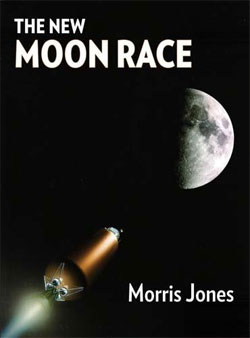Review: The New Moon Raceby Jeff Foust
|
| As for the title of the book, Jones punts on the question of whether there is a new “Moon race” forming between the United States and China, saying that while it “is a highly pressing question, it is also a very open question.” |
Author Morris Jones, an Australian spaceflight analyst, offers a relatively high-level view of the past, present, and future of lunar exploration in this book. After recounting the initial wave of missions to the Moon at the beginning of the Space Age and the scattering of missions there since then, he delves into the resurgence of interest in the Moon, particularly by emerging space powers such as China and India, which launched their first lunar missions in 2007 and 2008, respectively. Jones goes beyond robotic exploration to examine—and speculate—about human missions to the Moon as well, including both NASA’s current plans and potential missions by China, India, and other countries. Private missions to the Moon, including Space Adventures’ proposal for a Soyuz circumlunar flight and the Google Lunar X PRIZE, are also discussed.
Perhaps the biggest area of interest, and speculation, in the book is the discussion of Chinese human lunar exploration. Jones goes to great lengths to discuss how China could carry out such missions with various configurations of launch vehicles and spacecraft, all accompanied by relatively crude Photoshopped illustrations by the author, given the lack of official Chinese imagery. The problem is that it’s difficult to draw the line between what the Chinese could do (at least in the imagination of the author) and what the Chinese are actually planning to do. (There’s similar speculation, although to a lesser degree, about potential India human lunar missions.) In short, while an interesting thought exercise, it’s not clear how much of this—if any—reflects any Chinese plans for human missions to the Moon.
As for the title of the book, Jones punts on the question of whether there is a new “Moon race” forming between the United States and China, saying that while it “is a highly pressing question, it is also a very open question.” He does suggest, though, that there is such a competition forming among Asian space powers, specifically China, India, and Japan, all of whom have flown lunar missions in the last two years with additional missions on the drawing boards. It’s unfortunate, then, that there’s not more information about those current missions in the book: Chang’e-1, Chandrayaan-1, and Kaguya are all squeezed into the same chapter, with relatively basic information about each, while NASA’s LRO and LCROSS missions—scheduled for launch later this month—get their own chapter.
And as for claims that China will send humans to the Moon before the US, a recent news story by the official Chinese news agency Xinhua quoted the “chief designer” of the Chang’e spacecraft as saying that scientists were examining the feasibility of such missions “at an appropriate time between 2025 and 2030,” significantly later than earlier reports. That would seem to quash any claims that China would beat the US back to the Moon, but given the uncertain future of NASA’s current exploration plans, one never knows.
